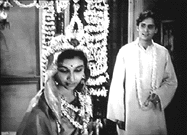Times are hard in the city of Calcutta. Apu’s (Soumitra Chatterjee) college funds have run dry, and he is forced to suspend his university education. After receiving a letter of introduction from a supportive professor, Apu exits the faculty office only to walk into the chaos of a student protest. It is a harbinger of his professional uncertainty. With an intermediate college education and possessing few manual skills, he is either overqualified (to paste labels on medicine bottles), or underqualified (to teach grade school children) . But there is hope. One of his stories has been accepted for publication, and a career as a writer seems to have potential. One day, he is visited by a college friend, Pulu (Swapan Mukherjee), who has been searching for him around town in order to invite him to his cousin Aparna’s (Sharmila Tagore) wedding. Pulu has a job in mind for Apu, one that uses his typing skills, but Apu is reluctant to settle into a life of complacency with a “desk job”. Apu reveals to Pulu that he has been working on a novel about the saga of a poor village boy. Pulu immediately recognizes the factual similarity to the author, but teases Apu on his romantic qualifications for introducing a fictitious “love interest” into the novel. Arriving to Khulna for the wedding, the bride’s mother (Sefalika Devi) is charmed by the handsome, mild-mannered Apu, and flatters him with comparisons to the deity, Krishna. Secretly, one can sense that she wishes that Aparna would marry Apu instead. When the bridegroom unexpectedly arrives to the wedding in a state of mental distress, the opportunity presents itself. The family believes that Aparna will be cursed if she does not marry as planned, and Apu is asked to act as a substitute bridegroom. Apu’s marriage to Aparna proves to be well suited, as the young couple settle into a blissful domestic life. However, their happiness is truncated when Aparna develops complications during childbirth. Unable to reconcile with his profound grief, Apu abandons all responsibility to wander the land in search of inner peace.
Apur Sansar is a poignant, triumphant final chapter to Satyajit Ray’s epic masterpiece, the Apu Trilogy. As in Pather Panchali and Aparajito, Apu Sansar concludes with an image of Apu traveling away from the the safe and familiar surroundings of the past, facing an uncertain path to the future. It is a symbolic road that he has taken throughout his life: through economic necessity, academic pursuit, and personal tragedy. The serene, final shot shows Apu once again on the familiar journey. But this time proves to be different. He is no longer leaving – he is going home.
Satyajit Ray’s ability to move the audience without melodrama or emotional manipulation is a precise art. In depicting the life of a simple village boy in the early 1900’s, Ray presents: the emotional struggle between cultural tradition and modernization, the vestigial effects of imperialism, the inescapability of social class. There are not enough words to describe the natural beauty and seamless cinematography of the Apu Trilogy. The films, like life itself, need to be experienced through all their joy and pain.
© Acquarello 2000. All rights reserved.
